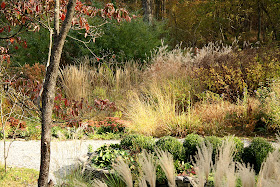This simple planting of Birch, Amelanchier, Huechera, and Carex has remained a favorite of mine through many visits to the High Line. It's a good illustration of how a layered planting can work--small trees or shrubs underplanted with a simple, pared-down selection of perennials--a good way to pack a lot of impact into a small space.
Much as I admire this extraordinary community of plants, it is not a natural environment. It is, in fact, a giant planting box embedded in a concrete surface. It bears some comparison to an exhibit in a zoo.
How strange that a naturally evolving and self-sustaining community of plants on an abandoned railroad trestle could have been the genesis of such a sophisticated, very expensive, and ultimately unsustainable construct as the High Line (unsustainable because it can't continue to exist on its own). This High Line seems almost a contradiction of the original, "natural" High Line.
Don't get me wrong. I admire the High Line as a masterpiece of garden and urban landscape design. But I think we need to call a spade a spade. This is a complex recreational, aesthetic, and perhaps spiritual machine, requiring enormous amounts of money and labor to create and maintain it. Without continuous funding, knowledgeable planting and horticultural expertise, and hordes of maintenance and security forces, it couldn't continue. It is not natural, and anyone who tells you otherwise is selling you a bill of goods.
But it is a superb example of naturalistic planting, and the horticultural practices that sustain its plant life are derived directly from observation of nature. This simple planting uses small trees and shrubs to create a micro-enrivonment. Within their shade only two perennials--carefully selected for their ability to thrive in understory, rocky conditions, and for their aesthetic qualities--make a beautiful design.
Both Heuchera villosa 'Brownies' and Carex eburnea look great in their rectangular island planting, even now, well into autumn. They are reminders of "Nature" in the big sense, but also of nature on a stage set, displayed with great self-consciousness and much forethought, the better to attract the interest of the human ecology of the High Line ...
... for
human ecology is very much what the High Line is about.












































































